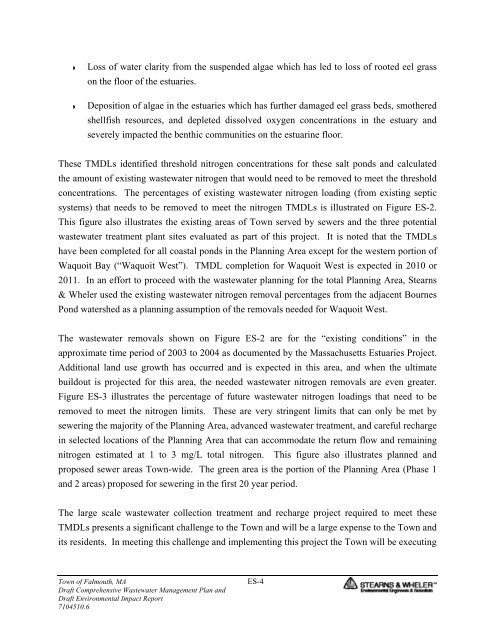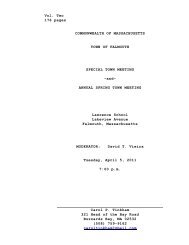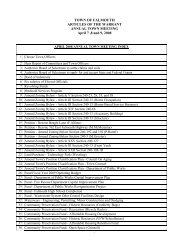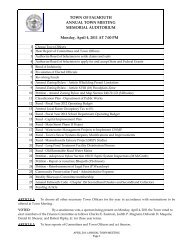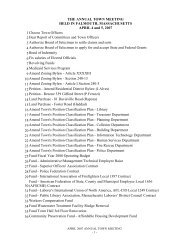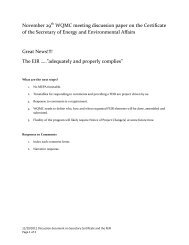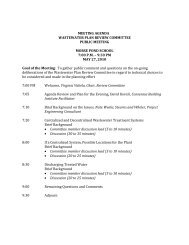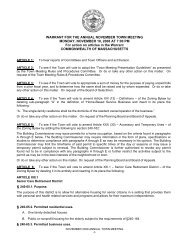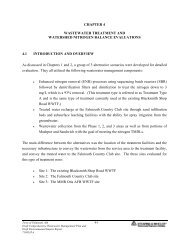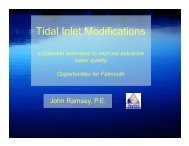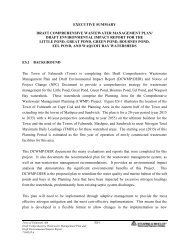EXECUTIVE SUMMARY (Without Figures) rev - Town of Falmouth
EXECUTIVE SUMMARY (Without Figures) rev - Town of Falmouth
EXECUTIVE SUMMARY (Without Figures) rev - Town of Falmouth
You also want an ePaper? Increase the reach of your titles
YUMPU automatically turns print PDFs into web optimized ePapers that Google loves.
Loss <strong>of</strong> water clarity from the suspended algae which has led to loss <strong>of</strong> rooted eel grass<br />
on the floor <strong>of</strong> the estuaries.<br />
Deposition <strong>of</strong> algae in the estuaries which has further damaged eel grass beds, smothered<br />
shellfish resources, and depleted dissolved oxygen concentrations in the estuary and<br />
severely impacted the benthic communities on the estuarine floor.<br />
These TMDLs identified threshold nitrogen concentrations for these salt ponds and calculated<br />
the amount <strong>of</strong> existing wastewater nitrogen that would need to be removed to meet the threshold<br />
concentrations. The percentages <strong>of</strong> existing wastewater nitrogen loading (from existing septic<br />
systems) that needs to be removed to meet the nitrogen TMDLs is illustrated on Figure ES-2.<br />
This figure also illustrates the existing areas <strong>of</strong> <strong>Town</strong> served by sewers and the three potential<br />
wastewater treatment plant sites evaluated as part <strong>of</strong> this project. It is noted that the TMDLs<br />
have been completed for all coastal ponds in the Planning Area except for the western portion <strong>of</strong><br />
Waquoit Bay (“Waquoit West”). TMDL completion for Waquoit West is expected in 2010 or<br />
2011. In an effort to proceed with the wastewater planning for the total Planning Area, Stearns<br />
& Wheler used the existing wastewater nitrogen removal percentages from the adjacent Bournes<br />
Pond watershed as a planning assumption <strong>of</strong> the removals needed for Waquoit West.<br />
The wastewater removals shown on Figure ES-2 are for the “existing conditions” in the<br />
approximate time period <strong>of</strong> 2003 to 2004 as documented by the Massachusetts Estuaries Project.<br />
Additional land use growth has occurred and is expected in this area, and when the ultimate<br />
buildout is projected for this area, the needed wastewater nitrogen removals are even greater.<br />
Figure ES-3 illustrates the percentage <strong>of</strong> future wastewater nitrogen loadings that need to be<br />
removed to meet the nitrogen limits. These are very stringent limits that can only be met by<br />
sewering the majority <strong>of</strong> the Planning Area, advanced wastewater treatment, and careful recharge<br />
in selected locations <strong>of</strong> the Planning Area that can accommodate the return flow and remaining<br />
nitrogen estimated at 1 to 3 mg/L total nitrogen. This figure also illustrates planned and<br />
proposed sewer areas <strong>Town</strong>-wide. The green area is the portion <strong>of</strong> the Planning Area (Phase 1<br />
and 2 areas) proposed for sewering in the first 20 year period.<br />
The large scale wastewater collection treatment and recharge project required to meet these<br />
TMDLs presents a significant challenge to the <strong>Town</strong> and will be a large expense to the <strong>Town</strong> and<br />
its residents. In meeting this challenge and implementing this project the <strong>Town</strong> will be executing<br />
<strong>Town</strong> <strong>of</strong> <strong>Falmouth</strong>, MA ES-4<br />
Draft Comprehensive Wastewater Management Plan and<br />
Draft Environmental Impact Report<br />
7104510.6


